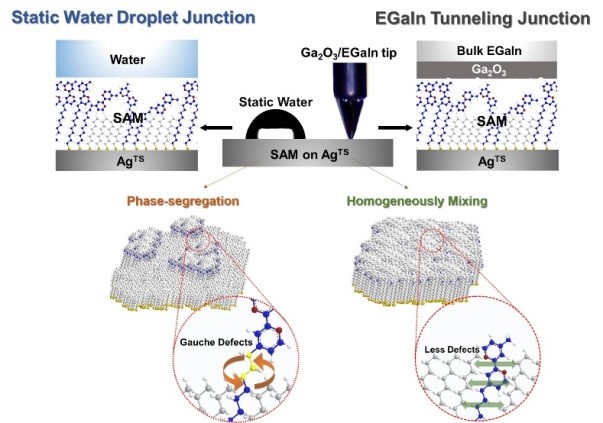

Gyu Don Kong(공규돈, 박사과정, 제1저자) / Junji Jin(김준길, 석사과정, 제2저자)
Interfacial
chemistry at organic-inorganic contact critically determines function of a wide
range of molecular and organic electronic devices and other systems. The
chemistry is, however, difficult to understand due to the lack of easily
accessible in-operando spectroscopic techniques that permit access to
interfacial structure on a molecular scale. Herein we compare two analogous
junctions formed with identical organic thin film and different liquid
top-contacts (water droplet vs. eutectic gallium indium alloy) and elucidate
the puzzling interfacial characteristics. Specifically, we fine-tune the
surface topography of the organic surface using mixed self-assembled monolayers
(SAMs): single component SAM composed of rectifier (2,2’-bipyridyl-terminated n-undecanethiolate; denoted as SC11BIPY)
is systematically diluted with non-rectifying n-alkanethiolates of different lengths (denoted as SCn
where n=8, 10, 12, 14, 16, 18). Characterization of the resulting mixed SAMs in
wettability and tunneling currents with the two separate liquid top-contacts
allow us to investigate the role of phase segregation and gauche defect in the
SAM//liquid interfaces. The results reported here show the difference in length
between SC11BIPY and SCn is translated into nanoscopic pits
and gauche-conformer defects on the surface, and the difference in contact
force—hydrostatic vs. user pressures—and hence conformity of contact accounts
for the difference in wettability and rectification behaviors. Our work
provides an insight into the role of molecule-electrode interfacial defects in
performance of molecular-scale electronic devices.

https://pubs.acs.org/doi/
 Fluorescence enhancement of a ligand-activated fluorescent pr...
Fluorescence enhancement of a ligand-activated fluorescent pr...
 PDMS-Coated Hypercrosslinked Porous Organic Polymers Modified...
PDMS-Coated Hypercrosslinked Porous Organic Polymers Modified...

















